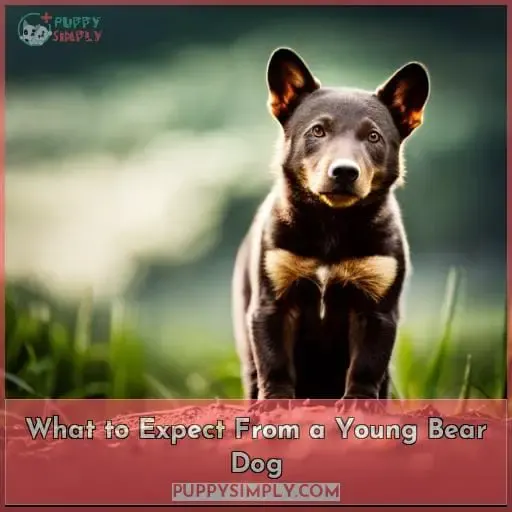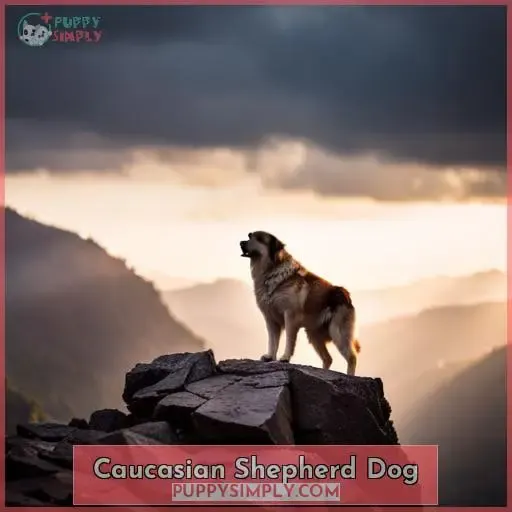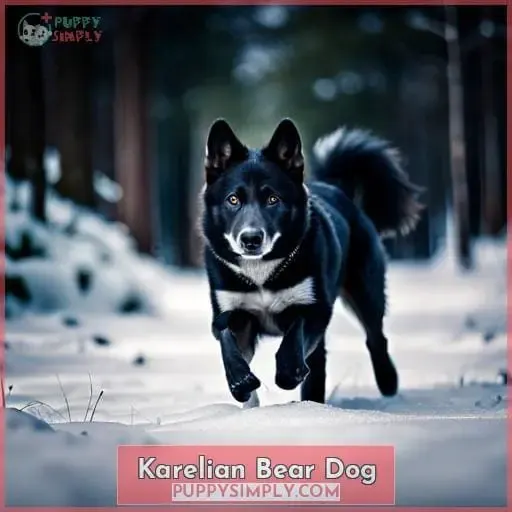This site is supported by our readers. We may earn a commission, at no cost to you, if you purchase through links.
When bear hunting with dogs, you’ll need tough, tenacious breeds** capable of tracking, baying, and withstanding a bear’s immense power.
Popular bear hunting dogs include the Caucasian Shepherd, a fearless, muscular livestock guardian, and the Karelian Bear Dog, an agile, tireless Finnish breed.
You’ll want a pup with a strong prey drive, confidence, and trainability.
Proper gear like tracking collars, catch dogs, and durable leads is essential.
With the right dog and equipment, you can responsibly pursue this ancient, exhilarating tradition—if you’re prepared for what comes next.
Table Of Contents
Key Takeaways

- Bear hunting requires the right tools and a suitable bear hunting dog.
- Breeds suitable for bear hunting include Caucasian Shepherd Dogs, Karelian Bear Dogs, Plott Hounds, Redticks, Alaskan Malamutes, Kemp Walker Hounds, and Chinese Bear Dogs.
- Bear hunting dogs require early training, consistent commands, and positive reinforcement.
- Bear hunting dogs have high exercise needs and require regular, strenuous exercise to stay in peak condition.
Bear Hunting Dogs
If you’re looking for a loyal, dependable, and hard-working companion to join your outdoor pursuits, then look no further than the various breeds of hounds that were bred by European settlers specifically for their grit and staying power.
From Plott Hounds to Redticks, these dogs are renowned for their hunting strategies and training techniques. But when it comes to bear hunting, there are several breeds that stand out above the rest.
The Plott is highly regarded amongst bear hunters due to its tenacity in tracking game over long distances – a trait inherited from its ancestor, Tibetan Mastiffs.
Additionally, Karelian Bear Dogs have been used extensively in Finland since ancient times as versatile big game hunters capable of tackling bears with ease thanks to their strength and determination. Alaskan Malamutes make an ideal partner with their impressive scent detection skillset, which can be essential on cold winter days spent deep within dense forestation seeking bears’ dens or trails through snow drifts higher up mountain sides.
And let’s not forget about Walkers. Kemp Walker hound breeders, such as Mike Kemp, specialize in producing some of the most sought-after dogs noted for having an exceptional treeing ability when pursuing bruins over challenging terrain like rocky ridges or heavily wooded areas – often working longer hours than even traditional coonhounds!
The Redtick also has strong ties within this arena, being well recognized by locals across North America who use them regularly due to both speed and stamina combined. However, they could be considered somewhat stubborn compared to Caucasian Shepherd Dogs, which makes them more difficult to train but still remain popular choices nonetheless.
So if you’re considering taking part in this thrilling pursuit, don’t hesitate to research any one particular breed mentioned here before making your decision.
How to Pick a Bear Dog Pup
Choosing a pup for bear hunting can be an exciting yet challenging task, as you’ll want to find one that has the right traits and temperament for your specific needs.
- Training Tips: Look for dogs with prior experience in tracking game or those accustomed to working in cold weather environments if you plan on taking them out during the winter months.
- Feeding Habits: Choose breeds that are known to have hearty appetites, such as Tibetan Mastiffs or Alaskan Malamutes, since they may require more sustenance while traversing long distances over rugged terrain.
- Temperament Considerations: Native breed of Finland, Karelian Bear Dogs tend to be obedient and loyal but also independent thinkers; whereas Plott Hounds are strong-willed yet easy-going when properly socialized from a young age – perfect qualities needed by any successful hunter!
- Health Requirements & Exercise Needs: Ensure any prospective pup is up-to-date with their vaccinations before bringing them home and consult local veterinarians regarding recommended exercise regimes so they stay fit throughout their lifetime.
Whether you’re looking at Kemp Walker hounds bred by Mike Kemp himself or Eugene Walker’s redtick variety, there’s no denying each offers something unique when it comes time to choosing your next faithful companion who will accompany you through thick brushwood forestation seeking bears’ dens high upon mountain sides! Make sure whatever decision is made is based on what works best within your particular situation rather than simply looks alone – remember every breed has its own set of characteristics which should match closely against personal requirements firstly before anything else.
What to Expect From a Young Bear Dog
When you bring home a young bear dog, be prepared for an energetic pup who loves to explore and needs plenty of exercise. Chinese Bear Dogs are the most powerful breed of dog native to China and have been used by local people for centuries in bear hunting.
When selecting your pup, it’s important to consider their feeding requirements as well as training methods that will suit both you and your new furry friend.
Health concerns should also be taken into account when choosing a puppy – ensure they have had all necessary vaccinations before bringing them home! In addition, bear dogs can exhibit certain behavioral traits that may require extra attention during training sessions, such as increased aggression or excessive barking.
Exercise needs must not be overlooked either. These pups need regular physical activity to stay healthy and happy, including daily runs outdoors if possible or even visits to nearby parks where likeminded owners congregate for socialization purposes too!
Lastly, don’t forget about the best dogs out there – Plotts hounds, bred by Mike Kemp himself, provide tenacity and treeing ability, while red ticks offer strong noses and speed. These two breeds are ideal choices among experienced hunters alike. With some careful consideration and preparation beforehand, however, any budding hunter will find themselves equipped and ready to take great pride in the ownership of a wonderful companion to accompany them through unforgettable adventures in the wilds.
Basic Gear for a Bear Hunting Hound
Outfitting your hound for bear hunting requires the right gear; investing in quality items will ensure they’re safe and comfortable while on the hunt.
- Training Requirements: A well-trained dog is a successful hunter, which means appropriate training methods must be employed to help prepare them for their upcoming adventures. Practicing commands such as come and stay can protect your pup from potential danger during a hunt.
- Kennel Basics: Your hound deserves an enclosed space of its own where it’ll feel safe and secure when not actively participating in hunts, or after returning home from one.
- Collar Options: Selecting the correct collar size is important because too small could cause discomfort while too large might slip off easily – neither of which bodes well for tracking down prey on difficult terrain! Consider adjustable collars that grow alongside puppies as they age so you don’t have to replace often over time either!
- Bait Strategies & Health Care Necessities: In addition to finding proper bait strategies (such as scents) tailored specifically towards attracting big game animals such as black bears during hunts, make sure all necessary health care essentials are packed away before heading out – this includes flea/tick treatments & preventative medications among other things!
With these key elements accounted for prior to embarking upon any bear hunts, owners can rest assured knowing their working dogs will be adequately prepared at all times.
Caucasian Shepherd Dog
The Caucasian Shepherd Dog is a large, powerful breed known for its loyalty, intelligence, and bravery. Originally from the Caucasus Mountains in Georgia and surrounding countries, it was bred to protect livestock from predators like wolves.
This breed is highly regarded by people of its homeland due to their strong work ethic, even under harsh conditions such as those found in the native habitat.
Socialization Needs:
- Moderate/Early socialization needed; Introduce pup slowly and gradually to new situations and people
Breeding Traits:
- Bred for protection; Large size with heavy bones and a big head; Thick double coat
Temperament Traits:
- Intelligent but independent nature
- Fearless guardian instinct
- Protective of family but can be aggressive towards strangers
Training Tips:
- Begin training early – basic commands essential
- Follow through consistently using positive reinforcement
Exercise Needs:
- High energy needs – long daily walks/runs + playtime
- Requires outdoor space or access when possible
Monitor behavior carefully when around other animals. Tireless stamina makes them ideal herding dogs.
Karelian Bear Dog
You’ll find the Karelian Bear Dog to be an independent, tenacious hunter with a strong will and fearless nature.
Training essentials are key when it comes to owning a Karelian Bear Dog. The dog must learn early on who is in charge; they need consistent commands and positive reinforcement.
Health concerns include hip dysplasia, eye problems such as cataracts or glaucoma, and ear infections from water exposure during bathing or swimming. Lapses of judgement while out hunting can also result in injury if not supervised properly.
Temperament traits vary, but some individuals may exhibit guarding behaviors towards strangers due to their protective instinct.
Exercise needs are high – daily walks/runs plus playtime. These active pups require access outdoors whenever possible, though caution should always be taken near other animals since this breed has tireless stamina, making them ideal herding dogs too!
Hunting techniques recommended by experts involve pairing up two experienced hunters together, with each taking turns tracking different scent trails. This increases chances of success while learning how Kemp Walker hounds work best under pressure situations, allowing both humans and canines alike ample opportunities to further hone skills needed for successful outings time and again, where everyone lives happily ever after.
Frequently Asked Questions (FAQs)
What is the average lifespan of a bear hunting dog?
With proper care, a bear hunting dog can have an average lifespan of 10-14 years. Utilizing the strength and power of such breeds, you can experience a lifetime adventure as your companion stands by your side.
Are bear hunting dogs suitable for children?
Bear hunting dogs can be suitable for children, as long as they are properly trained and socialized. They possess the traits of strength, agility, loyalty, and intelligence that make them great companions in an active lifestyle.
With their excellent tracking ability combined with obedience training and supervision from adults, these dogs can provide hours of enjoyment for both kids and parents alike.
Are bear hunting dogs good with other animals?
Yes, bear hunting dogs are generally good with other animals. They’re bred for their intelligence and trainability, making them adaptable to different environments and social situations. Their strong instincts keep them vigilant when it comes to protecting others, while their sociability ensures they get along well in group settings.
What is the best way to train a bear hunting dog?
Train a bear hunting dog by developing an understanding of their natural instincts and behaviors. Use positive reinforcement, consistency, and reward-based approaches to create a trusting relationship with your pet.
Make sure you provide them with plenty of exercise and stimulation to keep them engaged during training sessions.
How much exercise does a bear hunting dog need?
A bear hunting dog needs regular, strenuous exercise to stay in peak condition. To ensure your pup is at its best for the hunt, make sure it gets plenty of running and jumping opportunities every day.
Conclusion
In conclusion, bear hunting is an exciting and rewarding experience that requires a special kind of hound. The Plott, Walker, and English Coonhound are all popular bear hunting breeds that bring their own unique skills and tenacity to the hunt.
Selecting a bear hunting pup requires careful consideration, as each pup must be evaluated for its suitability.
Once you’ve selected a pup, you can use basic gear such as a lightweight kennel and collar to help train and care for your hound. For those looking for an alternative to the traditional bear hunting dog breeds, the Caucasian Shepherd and Karelian Bear Dog are also great choices.
With the right hound, gear, and training, you can be sure to have an enjoyable and successful bear hunting experience.










